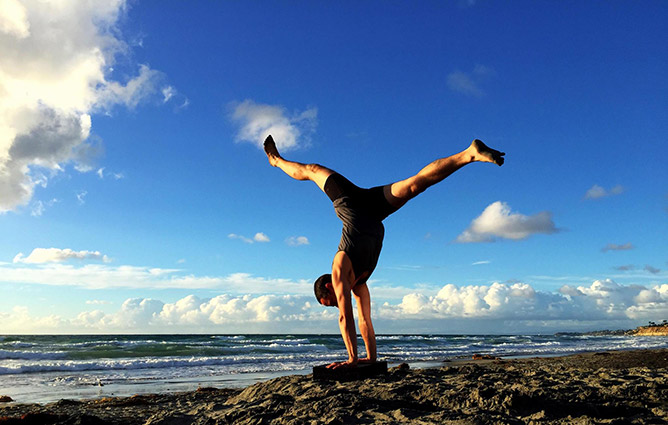Teaching Yoga to people with Autism
I started practising Yoga 32 years ago, when I was 16, the same age my eldest son Rafi is now.
Yoga helped me when I was young to stretch and lengthen my tight sport addled body. That, and some help with relaxation, was all I needed from it then.
Sixteen years later, my husband Charlie and I moved to Taiwan soon after Rafi was born. When he was only a few months old it was evident that Rafi was different.
Years later he was diagnosed with Autistic Spectrum Disorder (ASD) but at the time we had no idea what the issues were or how to help him, except to love and protect him and follow our hearts. Having a baby who won’t go to others, who won’t hug you and who seems to be uncomfortable so much of the time is a big worry for any parent, especially when so far from home.
That was when my Yoga practice really began. Yoga became a sanctuary for me. It helped me to learn patience and tolerance towards others as well as to observe and understand myself.
And now as a Yoga teacher, I know it can do the same for anyone who struggles with differences. Especially those with ASD themselves.
Rafi now has a lot of those quirky ASD characteristics we so often read about or see in films featuring characters with autism. He suffers from crippling social anxiety yet can talk to you for hours (yes, hours) about transitional metals. His favourite ones right now are osmium and tungsten.
It’s a daily battle for him fitting in to a big loud mainstream school and its “tedious and irrelevant” curriculum. Every night he tries to calm his racing mind to get a few hours of sleep. Life is often really tough for him.
I sometimes refer to him when teaching Yoga. Although it seems to Rafi that he is on the outside of human life as an observer, he has to learn how participate. He has to learn independence, how to deal with people and everyday situations and to manage his anxiety. After all, he’s going to be an adult soon.
In many ways his life is an exaggeration of the challenges we all face. He hates physical exercise but sometimes joins my yoga classes and last week told me: “It’s hard, but tolerable. I very much enjoy the feeling of relaxed clarity after the class.”
The non-competition, being able to choose the level of the pose and the fact that he doesn’t have to communicate, or even look into any one’s eyes, are big draws. The slow, steady pace of poses is comforting, breathing exercises help calm his anxiety and meditation is helping him to know his thought patterns and help him sleep better. Becoming more aware of his body, its growing strength, coordination and flexibility are big bonuses too.
Bella, one of my regular Yoga students who is an undergraduate at the National University of Singapore does volunteer work with kids and teens who have Autism spectrum disorders. She recently asked me to teach a Yoga class at a 3 day residential camp where there were to be 20 or so nuero typical -“normal”- teens, 25 teens with ASD and a few with others challenges such as Down Syndrome. During the program, they share dorms, go on excursions, make stuff and have a lot of fun together. I loved the idea of joining these diverse groups of people so they could all experience how the other world lives.
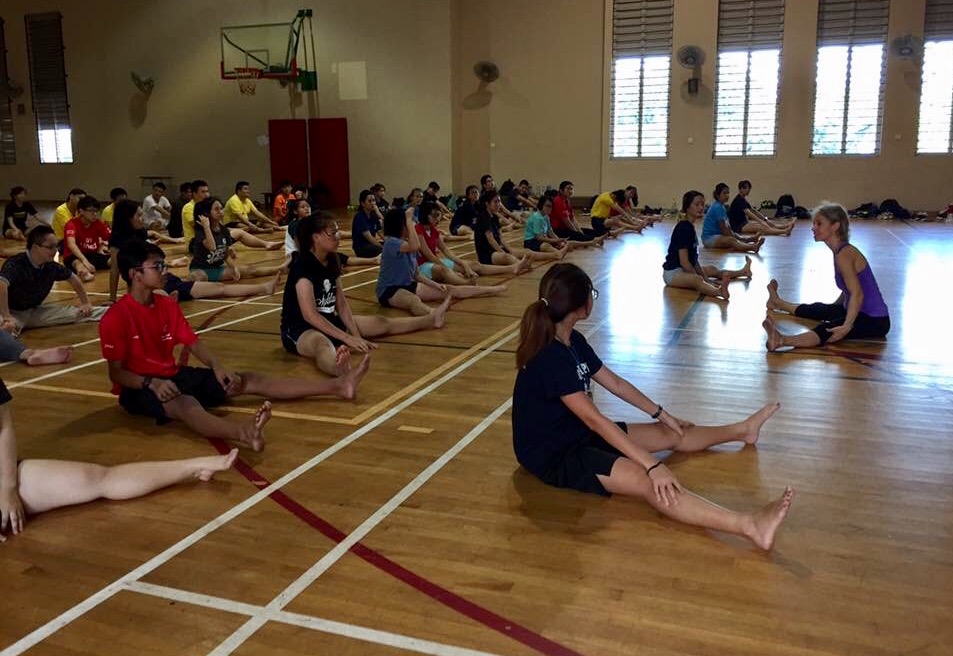
Class conditions were far from ideal. There were over 50 people with a huge range of abilities, in a big echoey school gym with no mats.
People with ASD are very sensitive to light so it needed to be as dim as possible, and visual distractions needed to be moved from the sides and front of the room.
Before class I met with Bella and her colleagues. I asked them to mix in and be part of the class so that if the kids couldn’t hear or see me, they had other visual guides. People with ASD are usually excellent visual learners and having assistants modeling poses is a helpful idea, especially in a big group.
It also needed to be made clear that it was OK for the kids to get poses somewhat or even completely wrong, and to not rush and correct them. This needed to be said as in Singapore, conforming is paramount. I wanted it to be clear that it didn’t matter if they didn’t do all I said and that they shouldn’t adjust or touch them. Even a seemingly harmless pat on the back can be highly disturbing to people with ASD. The supervisors got it and they were great.
In fact, everyone was completely focused. Whenever I looked at their sweaty faces, I saw either beaming smiles or complete concentration. I gave a quick thumbs up to a guy with Down Syndrome when after multiple tries he finally nailed tree pose. I could almost touch the sweet pride radiating from his smile.
After having some success with working on bite sized chunks, variations in sun salutations and simple standing poses, I threw in Half Moon for fun. There was laughter all round. Many of them were cheering for each other as they tried again and again in fits of giggles to balance. They’d never done this weird stuff with their bodies before.
That evening Bella kept sending me images of them throwing poses together in the canteen, the gym and dorms. These guys had become yoga fiends!
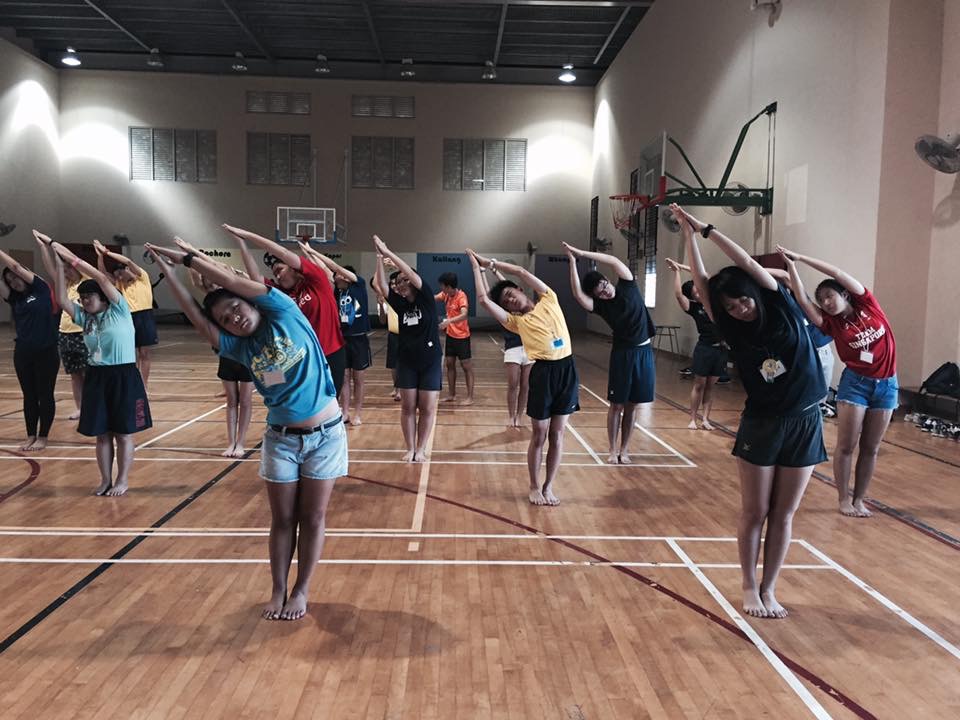
Directly after class, one guy plucked up the courage to come talk to me.
With no eye contact he said hurriedly, “You know that bit at the end, where you said what that word Namaste means about the light energy in us and how it’s the same in us all, and all that ”
“Yes,” I said.
“Is that really true? Do we all really have something inside that is the same in all of us and are we all really connected, together. The same. Really?”
“Well, yes I think we are.”
“Alright. I like that. Good. Goodbye”
So I encourage you teachers, well trained and experienced, to not be nervous about teaching people on the spectrum. If the statistics we read are right, worldwide the proportion of people with Autism is getting higher. This is a growing community of people and whether young or old they can really and truly benefit from yoga.
Here are some basic guidelines to teaching a class with ASD students:
1) Don’t feel insulted by non-communication or lack of eye contact. It’s all normal.
2) Repeat pose patterns and mini sequnces. Often. Familarity is comforting.
3) Cue a movement then pause, observe and wait for it to be done before the introducing the next one. A string of fast moving commands is just too much to mentally process. Demo and mirror with your body whenever possible. Be big and visual.
4) Don’t physically adjust at all. If students don’t get what you’re saying, say it or show it again in a different way. Be prepared to move on if they still haven’t got it. Strive for good alignment less than you would in other classes to reduce student anxiety.
5) Make sure there’s plenty of personal space between each student and each mat.
6) Smile and make jokes! It’s a great tension and anxiety breaker. Not all people with ASD can process facial expresions, but many can. And those that can’t, can definitely feel your energy and the energy in the rest of the class.
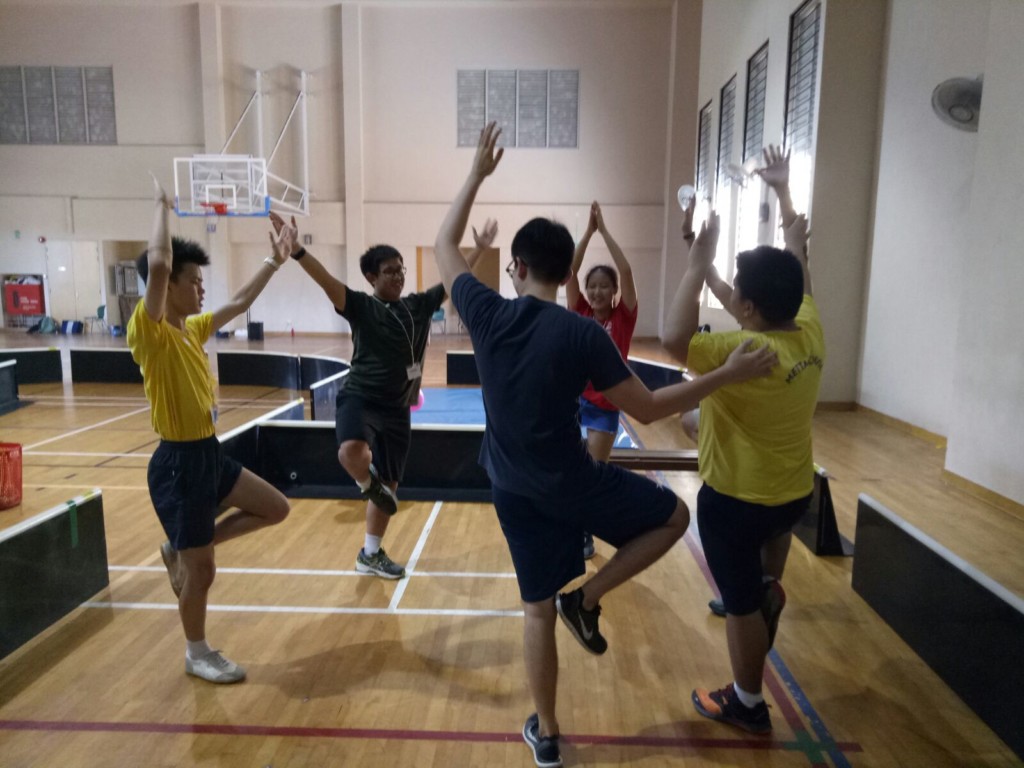
Bella and her team saw yoga as a tool to bridge the gap for two groups of people living very different lives. I see yoga as a tool for people with ASD to understand themselves and perhaps more significantly, as a way to make safe in-roads into this big scary world.
A yoga class offers people with ASD a break from social anxiety but is also safe place to get used to being around others. And with regular practice within a known group, they are given a chance to feel a sense of community and belonging – something I know my Rafi really needs.
There are already quite a few studios and teachers offering classes to young kids on the spectrum. Wouldn’t it be wonderful to see studios and independent teachers actively welcoming people with ASD?
Perhaps some classes could be offered as “Spectrum, Introvert or Just Plain Shy People, Welcome!” Would you go to that class? I know I would.
Today’s blogger, Sarah Barguirdjian, is a Singapore based yoga teacher and a graduate of the The Mazé Method 500 hour teacher training program.
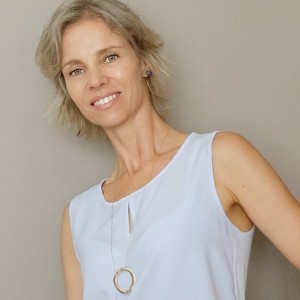 BIO: Sarah Barguirdjian was lucky to be introduced to Yoga as a teenager at school in England. She began teaching Yoga in Spain over ten years ago in a busy Tae Kwon Do studio and had a lot of fun introducing the high kickers and shouters to Yoga. She did her 500 hour training with Noah Maze who she continues to learn from. She has done a host of other teacher trainings with Desiree Rumburgh, Christina Sell, Sianna Sherman, Sarah Powers and Judith Hanson Lasater. She currently lives in Singapore with her husband Charlie and 2 boys aged 16 and 10 and teaches Yoga classes, workshops and retreats. Connect with her and other Yoga fiends from all over the world on her Facebook page and visit her site: www.sarahbyoga.net.
BIO: Sarah Barguirdjian was lucky to be introduced to Yoga as a teenager at school in England. She began teaching Yoga in Spain over ten years ago in a busy Tae Kwon Do studio and had a lot of fun introducing the high kickers and shouters to Yoga. She did her 500 hour training with Noah Maze who she continues to learn from. She has done a host of other teacher trainings with Desiree Rumburgh, Christina Sell, Sianna Sherman, Sarah Powers and Judith Hanson Lasater. She currently lives in Singapore with her husband Charlie and 2 boys aged 16 and 10 and teaches Yoga classes, workshops and retreats. Connect with her and other Yoga fiends from all over the world on her Facebook page and visit her site: www.sarahbyoga.net.
